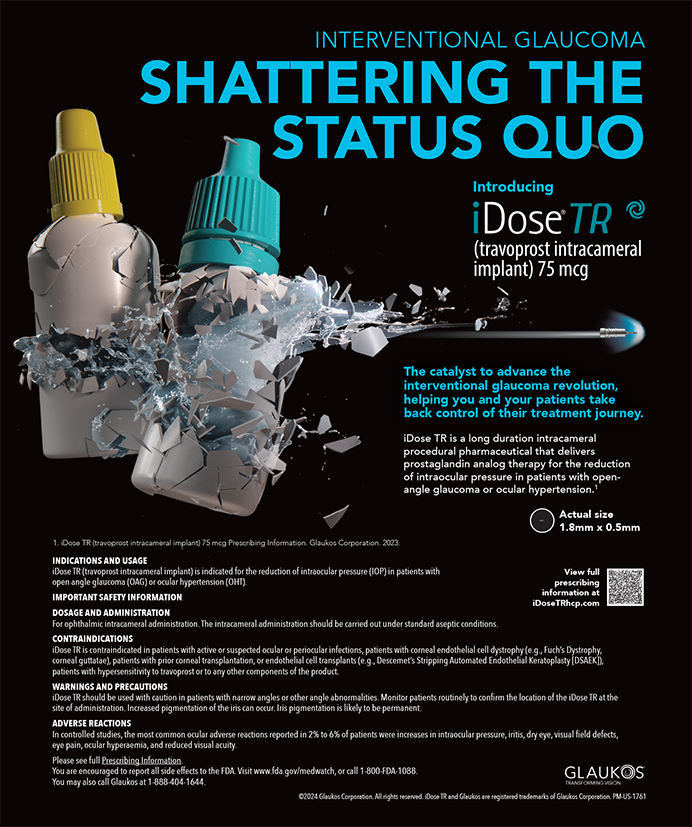Consider the following scenario. You have a demanding, high-profile patient who expects a perfect refractive outcome. Everyone in your office is anxious to meet his expectations, so you and your staff double-check his preoperative K-readings, scrutinize the measurement of his axial length, and carefully calculate the power for your favorite IOL. All of the parameters line up and seem to make sense. To your delight, the surgery goes well, and the patient's UCVA is 20/20 at his first postoperative visit. You and your staff indulge in a well-deserved round of self-congratulations.
Several months after surgery, however, the same patient returns stating he is unhappy with his vision. His UCVA measures 20/60, and a manifest refraction shows a -1.25 D myopic shift in his refractive error.
You and your staff are now scrambling for answers. A double-check of the patient's axial length and K-readings shows that all of your measurements were correct. A recalculation of the IOL's power with multiple formulas also confirms your original results. What is going on with this patient?
REMEMBER RELATIVE POWER
In the case described above, the most likely cause of the decline in the patient's uncorrected postoperative vision is an excessively large capsulorhexis. If the capsulorhexis is larger than the implanted IOL's optic, the forces exerted on the lens by the contraction of the capsular bag may shift the IOL anteriorly and increase its effective power.
We should always remember that in a two-lens system consisting of the cornea and an IOL, the IOL's effective power inside the pseudophakic eye is not absolute, but relative. For example, a 21.00 D lens (the power listed on the lens' box) will add that exact amount of power to the eye only if it remains in the position assumed by the formula used to calculate its strength (ie, at the plane of the zonules and completely confined within the capsular bag.) If a formula miscalculates the IOL's position by 0.50 mm and the optic ends up 0.50 mm more posterior to the cornea's principal plane, a 21.00 D IOL would produce only 20.00 D of correction.
Conversely, if a formula miscalculates the position of a 21.00 D IOL by 0.50 mm and the optic ends up 0.50 mm more anterior to the cornea's principal plane, then the lens would act as if it were a 22.00 D IOL. I always account for this effect by decreasing an IOL's power when it is implanted in the ciliary sulcus versus the capsular bag.1
ACCOUNT FOR CAPSULAR CHANGES
To ensure that an IOL's position in the capsular bag matches that anticipated by the formula used to calculate its power, the capsulorhexis should be round, centered, and smaller than the IOL's optic (Figure 1).
At the conclusion of the case, the optic should be centered directly beneath the capsulorhexis. Careful placement of the IOL allows the capsular bag to uniformly "shrink-wrap" around the lens' optic and maintain its proper centration.
The creation of centered, round capsulorhexes also encourages consistent refractive outcomes. Irregularly shaped and decentered capsulorhexes can contract asymmetrically, thereby exerting uneven forces on the IOL's optic and leading to decentration and tilt. Because the performance of new aspheric and pseudoaccommodative IOLs is particularly sensitive to their position in relation to the center of the pupil, decentration and tilt of these lenses can decrease their visual performance.
CONCLUSION
With any form of lens exchange, patients are increasingly demanding refractive perfection, and correctly configuring the capsulorhexis is no longer optional. Achieving good refractive outcomes with cataract surgery not only requires the correct calculation of the IOL's power but also the proper formation of the capsulorhexis.2 Therefore, every part of cataract surgery, excluding the placement of limbal relaxing incisions, should be directed toward preparing the capsular bag for the IOL's implantation.
Warren E. Hill, MD, is in private practice in Mesa, Arizona. He may be reached at (480) 981-6111; hill@doctor-hill.com.


